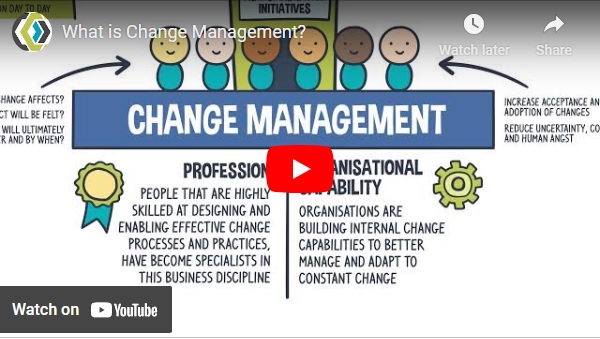The 3 Types of Change Management – Use Them All!

Introduction
Change Management is a term with at least three distinct meanings! Today we will define all three, but then advocate for the latter.
- The most widespread use of the term Change Management, at least in Project Management, means Scope Change Request Management. When the originally defined Scope either has to or has been requested to change, that change should be formally managed. Even if you are in an Agile environment, keeping track of when, how, and who authorized Scope Change is prudent.
- Another common use of the term Change Management is for versions of documents and code. This can include formal software systems or informal version control and migrations from one environment to another. This is always a good idea, although Google, SharePoint, and other specialized tools are doing more of that for us these days. Best practices dictate keeping track of document and code versions as they are edited and move along your workflow.
- The most important use of the term Change Management is Business Transformation Change Management (BTCM). It is the most important as it is the easiest to overlook or ignore. BTCM is about influencing people to do something different. It is usually about changing a Business Process and often includes automation of that process. Furthermore, it is about the resulting change in what people have to do day-to-day in their jobs, their workflows, their tasks, and their tools.
Anyone that believes that they are on “A Software Project” is at high risk of problems! Knowing that you are really on a project to “Change The Way People Work” and acting accordingly will greatly increase your chances of early and lasting success. Read on for perspectives on this key Change Management strategy.
Business Transformation Change Management (BTCM)
BTCM is an advanced set of processes to influence others that are used in important projects usually by fairly senior staff. A few of the many types of influence are leading by example, persuasive presentations, written and electronic communications, incentives, appealing to loyalty, meetings, and one-on-one communications.
The remainder of this post will outline the 3 Why’s to use Business Transformation Change Management. For a more detailed treatment, see our related post at https://www.dataanalysis.com/blog/3-whys-to-use-business-transformation-change-management
Why 1: Employee Engagement and Buy-In
Many operations, efforts, and projects attempting to implement process improvements or new tools ignore the feelings and communication needed for buy-in during the planning and implementation of change efforts. If for no other reason, BTCM should be used because projects just go a lot smoother if the prevailing spirit is one of positive thoughts. If there is a large contingent of either overtly or covertly people opposed to the project, it will take a lot more effort to bring it to successful conclusion.
Why 2: Smoother Adoption and Initial Use
Part of all project planning should be an assessment of what level of BTCM to use. This means not if to use it, but which tactics. Ultimately, you should ensure at least one influential project team member or sponsor level support person should carry the implicit title of Change Agent. Their responsibility is to assess the stakeholders with regard to how favorable they look at the project and how they can be influenced to become more of a proponent rather than an opponent. A couple of tactics that are usually useful can be found below.
- Positioning the project in a positive light to all the affected stakeholders, not just the team and management.
- Asking people for help, explaining their role in influencing, and giving them the tools to succeed in moving their associates toward a more positive view of the project.
- Being transparent and honest about the level of change and the effort it will take to get there.
Why 3: Lasting Value and Reduce Backsliding
How do we increase the chances of realizing Lasting Value and reduce the chances of Backsliding into the old ways and processes? To keep momentum for the actual changes instead of just on the project, add follow-up to your toolkit.
Setting adoption, new performance, and specific results goals will help. It will also help you to shine the spotlight on the early champions and early adopters and the results they are getting. Letting them tell the story in short videos, or at least in a public testimonials type of communication, may tip the scales to the newly hoped for status quo, which is the changed business process with its improved result potential.
Let’s hear some of the ways you have used to influence stakeholders about your projects. We will add the best ones to our best practices! Good luck and keep focused on the quiet ones. They may get you in the end!
Your path to business success.

